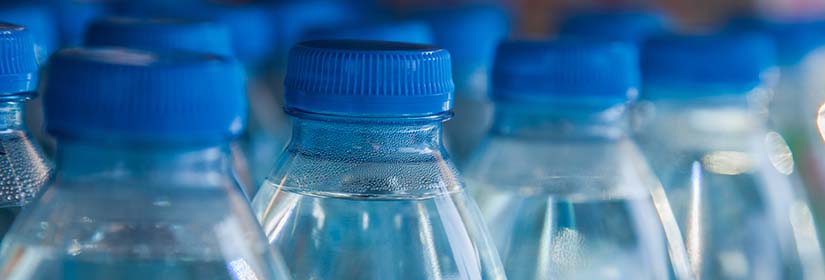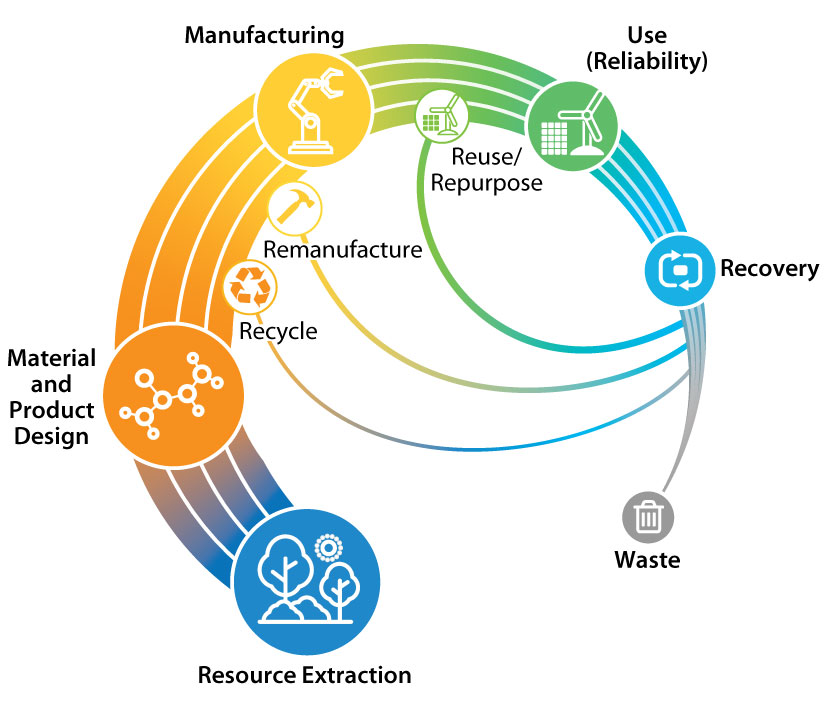
Circular Economy for Energy Materials
NREL's circular economy for energy materials critical objective creates opportunities for resource sustainability for essential supply chain materials.

Decarbonization of the U.S. economy will require rapid deployment of clean energy technologies. This will demand large amounts of materials—including scarce, critical materials. Ensuring these materials are available in the necessary quantities and at their highest value and function will necessitate a robust circular economy for energy materials.
Achieving Our Vision
To reduce supply chain limitations across energy technologies, NREL is:
- Developing novel, low-emissions materials
- Creating design architectures to increase recyclability
- Designing manufacturing processes that reduce material use
- Increasing technology lifetimes
- Conducting social, economic, and regulatory analyses that support a circular economy for energy materials.
We are also developing end-of-life material recovery strategies to ensure these materials are not disposed of in landfills (as is the common practice today), but continue to provide societal value.
It is important to have a just circular transition. NREL is exploring pathways to reduce waste and increase product innovation while supporting human health, livelihood, and job creation. A just circular transition should reduce inequalities and benefit all communities.
Key Research Areas
NREL envisions a future in which energy materials are manufactured more efficiently, built to last longer, and designed for reuse and recycling on retirement to ensure that resources and supply chains for the clean energy transition are secure and sustainable. The following research areas describe our path to achieving our vision.
As batteries proliferate in electric vehicles and stationary storage, we are exploring ways to increase the lifetime value of battery materials. Specifically, we are improving battery reuse, repair, and recycling while addressing barriers to the widespread adoption of these practices.
NREL is working to minimize waste streams from building construction through research on new materials and industrialized construction and by making buildings more durable. We are also developing design principles, modeling tools, and new economic models with circularity and carbon sequestration in mind.
Read more in the Circular Economy for Building Materials fact sheet.
Modeling and analysis underpin our work in the circular economy. Using innovative models and research capabilities, we provide credible, objective analyses of clean energy systems throughout their life cycles.
NREL is enhancing photovoltaic (PV) sustainability by increasing the energy produced by PV systems over their lifetimes while reducing the energy consumed in their manufacturing and installation. We are developing new materials, architectures, and manufacturing processes; studying PV system performance over time; and exploring ways to recover materials at end-of-life while minimizing negative environmental impacts.
Read more in the Circular Economy for Photovoltaics fact sheet.
Transitioning polymer materials to a circular economy will require improved recycling processes for today's plastics and a new, designed-for-circularity approach for tomorrow's low-fossil-carbon plastics. NREL is developing processes to break down today's most widely manufactured polymers, pursuing methods to upcycle waste plastic, and designing new polymers that are easier to recycle.
NREL is optimizing manufacturing supply/value chains by providing detailed assessments, benchmarking, and comparative cost and sensitivity analyses around all phases of a product's life cycle as well as data on material substitutions and distributed production.
We are designing tomorrow's wind energy technologies to use fewer resources, last longer, and break down more easily. Many components of wind turbines can already be recycled, and NREL is studying ways to encourage this. In addition, we are developing ways to make large turbine blades easier to recycle at end-of-life.
Transforming Energy Through Partnerships
Working with industry, government, research, and nonprofit partners, we can achieve our vision of a clean energy future for the world far faster and more efficiently than working on them alone. NREL is committed to ensuring our research gets to market—where it can improve everyday life and strengthen our economy. Learn more about working with NREL.
Contact
Share

